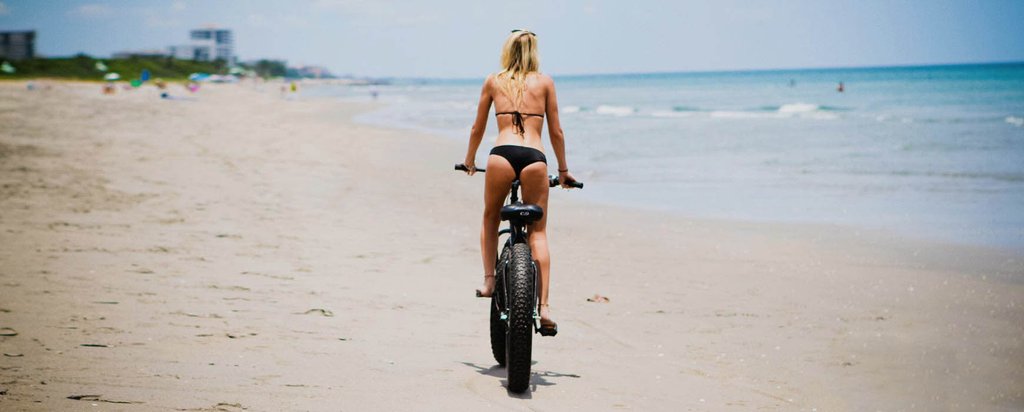Buying a new bike’s always a big decision, and purchasing a fat bike’s no different. You could just walk into a shop and start asking questions, but you won’t get far unless you’ve got a solid idea of what you’re looking for. First, you should at least understand what your own needs are.
Beyond that, you should know a few of the basic features of fat bikes. By asking yourself the right questions and learning what makes fat bikes special, you’ll wind up fat and happy with your purchase.
WHAT KIND OF TERRAIN ARE YOU GONNA SLAY?
Start by asking yourself where you plan to ride your fat bike. The point of having fat tires is to negotiate terrain that regular mountain bikes can’t. You’ll be able to power through sand and snow (but there is a limit to how soft the terrain can be). The fatter its tires are, the better your bike can ride through softer terrain. If you want to ride dirt trails, you should opt for a bike on the thinner end of the fat spectrum because it’ll handle better.
NOT EXPERIENCED? GET A READY-TO-RIDE FAT BIKE!
You can opt for maximum versatility by starting with a frame and building the rest of the bike specs yourself. Some frames can accommodate different sizes of tires, giving you more options for the the terrain you ride. You should, however, consider your experience level before going the custom route. If you’re new to fat biking (which is likely the case if you’re reading this), a ready-to-ride bike is the wiser choice. It requires much less thought and work than customizing a bike, and you’ll have an easier time selling a ready-to-ride bike than a customized one when you want a new bike. You can then go the custom route because your previous fat biking experience will help you hone in on exactly what you want and need.
HOW MUCH DO YOU WANT TO SPEND?
Customizing a fat bike can also be expensive, and budget should be one of your top considerations. You can find fat bikes across a wide price range, so finding one at your price point should be easy. As with other types of bikes, frame material determines a large portion of the cost. Steel frames are the least expensive, with aluminum alloys, carbon fiber, and titanium following. The more expensive fat bikes have a lighter frame, which is especially helpful because big tires add weight to a bike. Brake-type also influences price. Hydraulic brakes are more powerful than mechanical ones, and that power will help if you plan to ride your fat bike downhill.
KNOW YOUR FRAMES
Although they have less influence on price, the frame-type, rims, and tires will also factor into your buying decision. Most fat bikes must have a frame that can accommodate both wide tires and a full set of gears. Some bikes use an offset frame to get the job done, while others keep the frame symmetrical. An offset frame shifts 17.5 mm to the drive side of the bike, giving the hub on the rear wheel more space to accommodate the drive train and keeping the chain from rubbing against the rear tire. A symmetrical fat bike adds 17.5 mm of length to both sides of the hub to keep the frame in line. You can interchange wheels on an offset bike because the hub remains unchanged. If you’re riding in the wilderness and need to change your rear tire, you’ll want to be on an offset bike. Some riders, though, prefer the aesthetics of symmetrical bikes. There’s no discernible difference between how the two styles ride.
HOW FAT DO YOU WANNA GET?
On a basic level, rims and tires can go together as a single feature of a fat bike. The wider the rim is, the wider the tire it will accommodate. When choosing a tire width, your options are 3.8 in, 4 in, 5 in, and 5.5 in. Thinner tires offer more dynamic handling. Fatter tires provide more stability and can float at lower pressures, which helps them rotate on snow and sand. Wider rims and tires also add weight to a bike, which requires more of your effort to pedal on flat or uphill slopes. One solution for getting both fatter and faster is to get an electric fat bike. The motor on this type of bike gives you extra pedaling power, while the tire width lets you ride on snow and sand.
Fat bikes let you go places where regular mountain bikes do not. If you want a fat bike that will ride where you want to, you have to balance considerations such as terrain, your experience level, and your budget with the key features of fat bikes. The world of fat biking is constantly growing and innovating, you’ll find fat biking to be a lot more fun if you get off to a right start.




Share:
Electric Torque Bike For Kids Trailer
Fat Tire Bike Riding in the snow